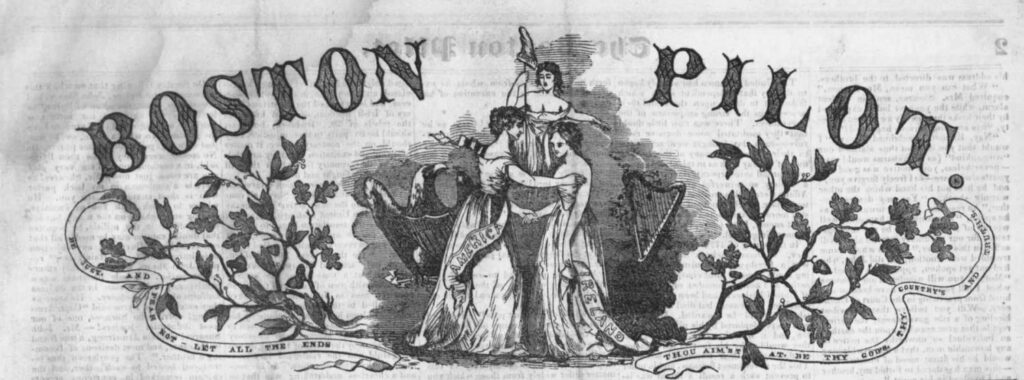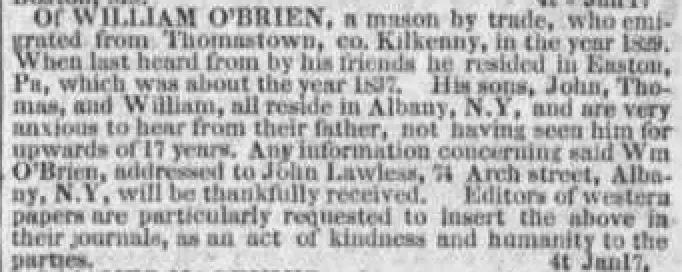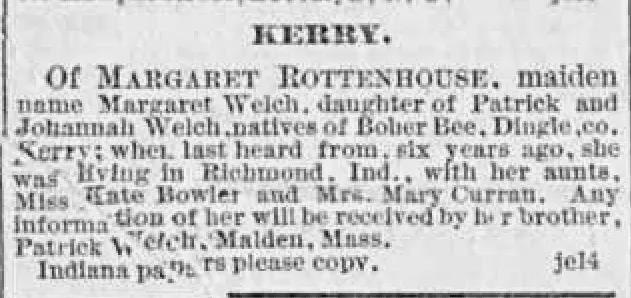
The Search for Missing Irish Family Members in Old Newspapers
For family historians, tracing lost ancestors can feel like searching for a needle in a haystack. Today, we have the advantage of digitized records, online databases, and DNA testing to aid our efforts. But how did families search for missing loved ones in the 19th and early 20th centuries?
One of the most powerful yet often overlooked resources for reconnecting lost Irish ancestors is historical newspapers. These publications served as lifelines for families desperate to find missing relatives, particularly in the wake of Ireland’s Great Famine and mass emigration to the United States.
The Power of the “Information Wanted” Ads
Between 1820 and the early 1900s, more than six million Irish immigrants arrived in the United States. Many left behind family members, never to hear from them again. Others disappeared within the growing cities of America, leaving their loved ones to search endlessly.

One extraordinary example of how families sought to reconnect is found in the pages of the Boston Pilot. From 1831 to 1921, this Irish Catholic newspaper ran a recurring column called Information Wanted, where individuals placed advertisements in search of missing family members and friends.
These advertisements weren’t just simple, heartfelt pleas for information; they were packed with details that can be extremely valuable to genealogists today. You might find:
- Physical descriptions: Height, build, distinguishing features.
- Parents’ names and maiden names: Essential for tracing lineage.
- Occupations: Providing clues about their lives and potential locations.
- Family relationships: Helping to build family connections.
- Last Known Addresses: Offering specific locations to investigate.
- Places of origin in Ireland: Pinpointing ancestral roots.
Real Examples from the Archives
Here are just a few of the thousands of ads placed in newspapers by Irish families searching for loved ones:
William O’Brien – January 17, 1846
“Of WILLIAM O’BRIEN, a mason by trade, who emigrated from Thomastown, co. Kilkenny, in the year 1829. When last hear from by his friends he resided in Easton, Pa, which was about the year 1837. His sons, John, Thomas, and William, all reside in Albany, N.Y, and are very anxious to hear from their father, not having seen him for upwards of 17 years. Any information concerning said Wm O’Brien, addressed to John Lawless, 74 Arch street, Albany, N.Y, will be thankfully received. Editors of western papers are particularly requested to insert the above in their journals, as an act of kindness and humanity to the parties.”
Michael & Philip McManus – April 3, 1847

“Of MICHAEL and PHILIP McMANUS, natives of co. Fermanagh, townland of Littlemount. Michael came to this country 12 years ago; he is a cooper by trade. Also, of PATRICK LEONARD, who married Mary McManus, sister to the above; three years ago they were in Toronto, Upper Canada. Their brother, Patrick McManus, would be happy to hear from them, as he has written different times for three years past and got no answer. Address him at Gloucester, Ma.”
Elenor Devoy – February 26, 1848
“Of ELENOR DEVOY and two children (her maiden name was Elenor Grady), from County Kildare, parish of Newbridge. They sailed from Liverpool 15th June 1847 for Quebec. It is supposed that Mrs. Devoy died at Grosse Isle. The eldest child is a boy named Thomas Devoy, aged about 9 or 10 years, and the other a girl of nearly two years named Julia. Any information will be thankfully received by William Hayden, West Wareham, Massachusetts.”
William Eustace – July 8, 1848

“Of WILLIAM EUSTACE, native of Newtown Berth or (unknown), parish of Athy, co. Kildare, who came to America about 5 years ago. When last heard from he was in Boston, Ma, where he married Bridget Hughes. Any information respecting him will be thankfully received by James Dugan, care of Mr. Michael Drury, Katahdin Iron Works, Ma.”
Margaret Rottenhouse – June 14, 1873
“Of MARGARET ROTTENHOUSE, maiden name Margaret Welch, daughter of Patrick and Johannah Welch, natives of Boher Bee, Dingle, co. Kerry; when last heard from six years ago, she was living in Richmond, Ind., with her aunts, Miss Kate Bowler and Mrs. Mary Curran. Any information of her will be received by her brother, Patrick Welch, Maiden, Mass. Indiana papers please copy.”
These stories, filled with longing and uncertainty, highlight the human cost of emigration and the desperate measures families took to stay connected.
Tips for Using Historical Newspapers to Find Missing Irish Ancestors
If you’re researching your Irish family history and believe a relative may have gone missing or lost contact, here are some strategies for using old newspapers to aid your search:
1. Search for “Information Wanted” Columns
Many Irish-American newspapers featured these types of advertisements, particularly in cities with large Irish immigrant populations such as Boston, New York, Philadelphia, and Chicago. The Boston Pilot is one of the most famous sources, but similar ads can be found in other publications.
2. Search by Name Variations and Misspellings
Irish surnames were often recorded differently in American newspapers due to phonetic spellings, illiteracy, or Anglicization. Try searching with:
- Different spelling variations (e.g., O’Donnell vs. Donnell)
- First name abbreviations or initials (Patrick vs. Pat)
- Nicknames that might have been used in records
3. Look for Clues in Passenger Lists and Naturalization Records
If an ancestor disappeared after arriving in America, check ship passenger lists, naturalization petitions, or employment records in conjunction with newspaper advertisements to track their movements. Many “Information Wanted” ads reference ship names and arrival dates. Search the U.S. Immigrants from Ireland, 1846-1851 collection at Storied.

4. Pay Attention to Last Known Locations
Many newspaper ads list a person’s last known residence or occupation. This information can help you search city directories, census records, and even land ownership documents to track their whereabouts.
5. Explore Other Newspaper Sections
Besides “Information Wanted” ads, consider searching:
- Death and obituary notices – Sometimes missing family members are mentioned in obituaries of their relatives.
- Court and legal records – Notices of missing persons, estate settlements, or lawsuits may provide new leads.
- Community and society columns – Reports from Irish immigrant associations, church events, or social gatherings could mention a lost family member.
6. Check Multiple Newspapers
Don’t limit your search to a single publication. Different newspapers served specific Irish communities across America. Checking multiple sources may reveal different details about the same missing person or show how a family’s search evolved over time.
7. Look for Follow Ups
After finding an initial “Information Wanted” advertisement, check subsequent issues for follow-up notices. Families often placed updates when they received new information or found their missing relative. These follow-up ads can reveal whether the search was successful and provide additional details about your ancestor’s circumstances or location changes that weren’t included in the original notice.
8. Pay Attention to Geographic Clues
These advertisements often mention specific Irish parishes, American neighborhoods, and migration routes between cities. These geographic references can map your ancestor’s journey from their precise origin in Ireland to their movements across America. Use these location details to target your research in parish records, city directories, and census documents in the exact places where your ancestor lived or traveled.
9. Look for Maiden Names
Women in these advertisements were often identified by both married and maiden names. This practice provides valuable documentation of female ancestry that might be difficult to find elsewhere.
10. Consider Extended Family
These notices frequently mention siblings, cousins, and other relatives who might be easier to track in records. Pay attention to all family members referenced, not just your direct ancestor. A missing individual might not appear in records, but their brother, sister, or cousin mentioned in the same advertisement might have left a more substantial paper trail. Following these collateral relatives can often lead you back to your direct ancestor.
11. Research Quarantine Stations

Many Irish immigrants fell ill during the journey or upon arrival and were detained at quarantine stations like Grosse Isle in Quebec, Staten Island in New York, or Deer Island in Boston. If advertisements mention a family member who “disappeared” upon arrival, check quarantine station records, which often documented deaths and orphaned children. Many immigrants died at these facilities, leaving family members to continue their journey alone or be placed in orphanages or with foster families.
Could You Find a Missing Irish Ancestor?
These historical advertisements reveal not just genealogical data but the human story of separation and longing that characterized the mass Irish emigration. They remind us that behind every name in our family tree was a person who belonged to a network of relationships, many of which were painfully severed by emigration.
For those researching Irish ancestry, exploring these “Information Wanted” columns might just provide the missing link in your family’s history—and a poignant glimpse into the experiences of those who came before us. If you’re interested in exploring more of these historical advertisements—or if you think one of your missing Irish ancestors might be hiding in the pages of an old newspaper—explore Storied to uncover their story.